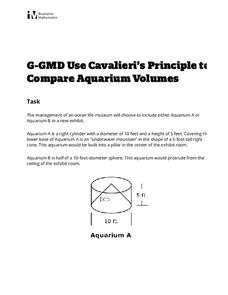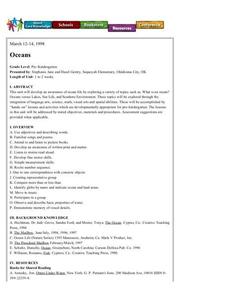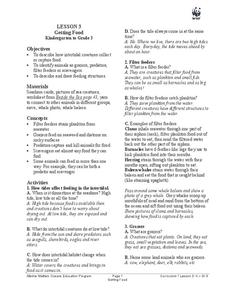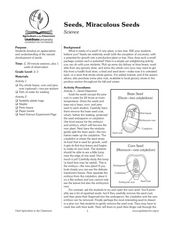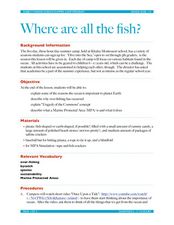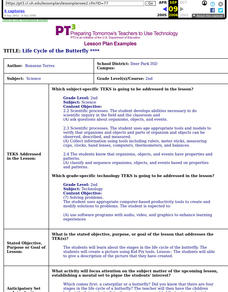Curated OER
Astronomy - Ancient Philosophies
Combine science and social studies with this collection of notes on ancient astronomy. Ideas propagated by early scientists influenced the way people viewed life and our place in the universe. Examine the philosophies of Aristotle,...
Illustrative Mathematics
Use Cavalieri’s Principle to Compare Aquarium Volumes
Learners are designing a stunning new water feature for an aquarium, but they soon discover that more than just a pretty home for their fishy friends is required. From calculating the volume of a composite shape through the...
Curated OER
What is a Fossil?
Students determine what a fossil is and distinguish between body fossils and trace fossils. They examine pictures of fossils and determine which represents a trace or body fossil.
Curated OER
What Is Radon?
Students examine what radon is and which isotope it belongs. They discuss the characteristics of isotopes in general and the atomic number. They complete a worksheet to complete the lesson.
Curated OER
Exploring Stars
Students discuss the life of a star and the different types of stars after watching the Discovery video "Exploring Stars". They create a flipbook that demonstrates the life of a star after collecting information on the life cycles of...
Curated OER
What Were Dinosaurs Like?
Students compare and contrast dinosaurs to animals that are alive today through basic research.
Curated OER
Building A Bug Bungalow
Students chart how milkweed bugs grow and change. In this growth and life stages lesson, students read two stories and discuss how and why things grow. Students brainstorm what can be measured about humans, review and discuss...
Curated OER
What Were Dinosaurs Like?
Students view a video clips about Dinosaurs. In this dinosaur lesson, students begin to understand the extinction of the dinosaurs by comparing them to contemporary animals. Students complete a research sheet on one dinosaur by...
Curated OER
Araceli Solis Butterflies Unit
Third graders study the life cycle, eating habits, habitats, and migration patterns of butterflies in this series of lessons.
Curated OER
The Intertidal Zone: Tide and How Creatures Survive
Learners explore oceanography by completing science worksheets. In this tide pools lesson, students discuss the forces of the tide pools, the animals that live within them, and the impact they have on the rest of the ocean. Learners...
Curated OER
Oceans
Students become aware of the differences between ocean water and lake water by smelling, tasting and seeing. They distinguish between land and bodies of water on a globe and gain increased awareness of oceans and life.
Curated OER
Getting Food
Learners complete activities to learn about the ocean food web. In this ocean life lesson, students discuss how the tides affect feeding, learn about filter feeders, grazers, predators, and scavengers. Learners then group the animals...
Curated OER
Energy Generating a Culture: Early American Coal Miners and Coal Mining Culture
Young scholars calculate how much coal they use based on their electric power usage. In this environmental science lesson, students trace the history of coal mining in US. They write a letter to USPS to encourage them to create coal...
Curated OER
Lights Light Up My Life
Students conduct an investigation. In this energy conservation lesson, students observe and make predictions about fluorescent and incandescent light bulbs. Working in groups, students conduct an investigation to compare the two light...
Curated OER
Seeds, Miraculous Seed
Students investigate relationships between plants and animals and how living things change during their lives. In this life cycle lesson, students split different types of seeds apart to see the beginning life stages of future plants.
Curated OER
Invertebrates
In this science instructional activity, middle schoolers answer the problems that are related to the concept of invertebrates. The first question has the ordering of and sorting of invertebrates.
Curated OER
The Life Cycle of a Butterfly
In this life cycle of a butterfly activity, students answer 7 short answer questions, draw a picture of a butterfly, answer 4 vocabulary questions and fill in 6 fill in the blank statements about butterflies.
Alabama Learning Exchange
Diverse Life Forms of the Ocean
Pupils recognize marine organisms and differentiate between plankton and nekton. In this investigative instructional activity students create a concept map using their list of terms and study marine life forms.
Curated OER
Biomedical Engineering and Quality of Life Improvements
Students complete an observational or natural science experiment. They do systematic and experimental work using experiments that have been done by others. They research their hypothesis and gather information from several sources. They...
Curated OER
Ocean Life Zones
In this ocean worksheet, students answer questions about ocean life, the plants and animals of the ocean and their classification, the major life zones of the ocean and questions about an animal of their choice that lives in the ocean.
Curated OER
Where Are All the Fish?
Students identify the problems that marine life is facing today. In this marine science instructional activity, students explain how Marine Protected Areas can help the ocean and the fish. They brainstorm ways to help in the conservation...
Curated OER
Life Cycle of the Butterfly
Second graders investigate the stages in the life cycle of the butterfly. They create a picture using Kid Pix tools. They give a description of the picture that they have created.
Curated OER
What Lives In A Shell?
Second graders study the readily observable characteristics of marine invertebrates, 2nd graders research the invertebrates and complete worksheets in this series of lessons.
Curated OER
What's in that Cake?
Learners discover the methods scientists use to investigate Oceanic habitats. In this oceanography instructional activity, students utilize the Internet to identify deep sea submersibles and how they help scientists study the...

